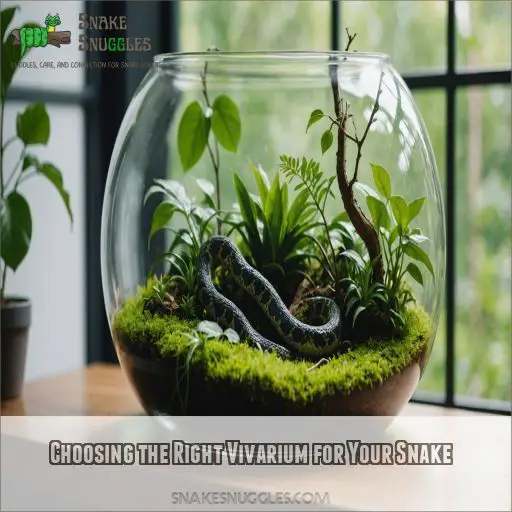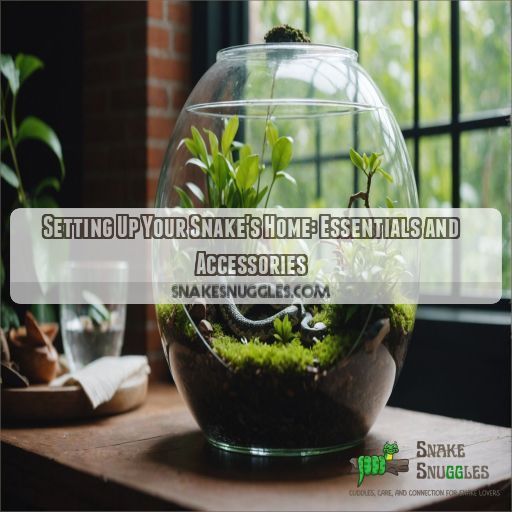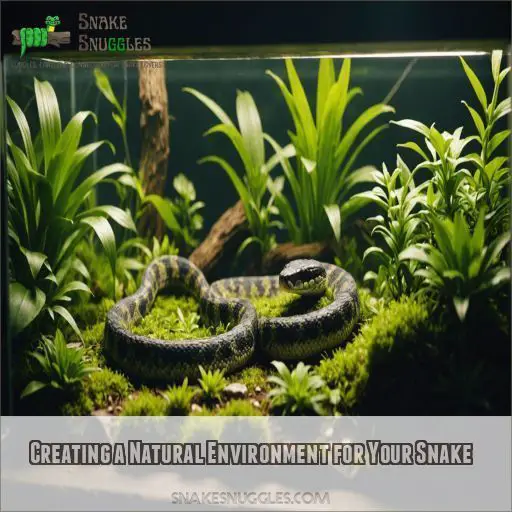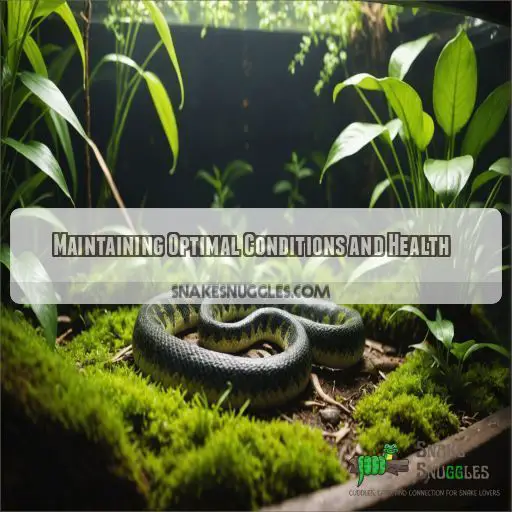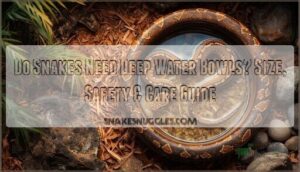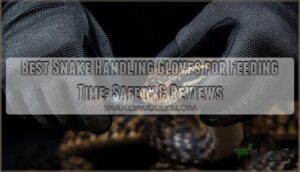This site is supported by our readers. We may earn a commission, at no cost to you, if you purchase through links.
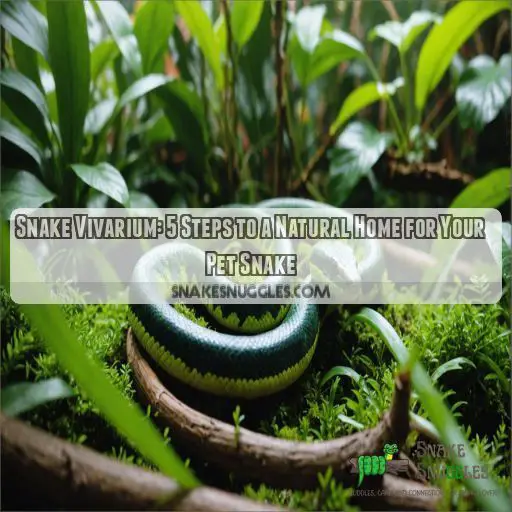
It’s an art form that combines comfort, safety, and a touch of the wild.
You’ll need to channel your inner herpetologist to craft a cozy haven that mimics your snake’s natural habitat.
From choosing the right size tank to nailing the perfect temperature gradient, every detail matters.
Don’t forget to add some snake-friendly décor – think branches for climbing and hiding spots for those introvert moments.
Ready to transform your snake’s home into a five-star reptile resort?
Table Of Contents
- Key Takeaways
- Choosing the Right Vivarium for Your Snake
- Setting Up Your Snake’s Home: Essentials and Accessories
- Creating a Natural Environment for Your Snake
- Maintaining Optimal Conditions and Health
- Top 10 Best Snake Vivariums and Accessories
- 1. Small Reptile Tank Terrarium Habitat
- 2. Zilla QuickBuild Glass Terrarium
- 3. ECOFLEX Reptile Habitat Enclosure
- 4. 120 Gallon Reptile Enclosure
- 5. Reptile Branch Decor for Terrariums
- 6. 34 Gallon Reptile Terrarium Tank
- 7. Reptile Terrarium Amphibian Tank
- 8. Mossy Caves Reptile Hide
- 9. 35 Gallon Glass Reptile Tank Terrarium
- 10. Exo Terra Forest Plume Moss 2 Pack
- Frequently Asked Questions (FAQs)
- Can you keep snakes in a vivarium?
- What is the difference between a vivarium and a terrarium?
- Why is it called a vivarium?
- What is a vivarium tank?
- How often should I replace the substrate?
- Can multiple snakes share the same vivarium?
- Are there snake-safe plants for bioactive setups?
- Whats the best way to clean vivarium decorations?
- How do I soundproof a snake vivarium?
- Conclusion
Key Takeaways
- Creating a snake vivarium isn’t just about tossing your scaly buddy into a glass box – it’s an art form that combines comfort, safety, and a touch of the wild. Think of yourself as a reptile interior designer!
- Temperature is key – your snake’s home should be a cozy retreat with a warm side (85-90°F) and a cool side (75-80°F). It’s like giving your snake a thermostat to control its own comfort zone.
- Deck out your snake’s pad with hiding spots, climbing branches, and safe plants. It’s like building a snake playground – they’ll be slithering with joy!
- Regular maintenance is crucial – from cleaning the substrate to vet check-ups. Think of it as being your snake’s personal butler and doctor rolled into one!
Choosing the Right Vivarium for Your Snake
Setting up a comfortable home for your snake means getting the right vivarium. You’ll want to think about your snake’s unique needs, from the right amount of space to the ideal humidity levels.
Considerations for Snake Species and Habitat Preferences
Picking the right vivarium for your snake is super important, especially since you want to make sure they’re happy and comfy. Each snake species has its own personality and needs, so let’s take a look at some popular pet snakes and what kind of home they’d love:
- Ball Pythons: These guys are pretty adaptable and like a mix of tree branches and underground hideouts. They come from west and central Africa, so they prefer a humid environment.
- Corn Snakes: These are active hunters that do well in both on-the-ground and tree-climbing settings. They’re not too fussy about humidity levels.
- Western Hognose Snake: These snakes are gentle and charming, known for their funny "playing dead" trick when they feel threatened. They’re from the semi-arid prairies and scrublands of North America.
- Florida King Snake: Another active hunter that enjoys a mix of on-the-ground and tree-climbing spots. They love having lots of places to burrow and hide.
- Rosy Boa: These snakes are from the American Southwest and are known for their pretty colors and gentle nature, making them popular pets for kids.
Available Tank Sizes for Snake Vivariums
Choosing the right vivarium for your snake involves considering various factors, including the species’ habitat preferences and available tank sizes. Here’s a breakdown of the options:
- Tank Sizes: Snake vivariums come in various sizes, including 10-gallon, 20-gallon long, 29-gallon, 40 breeder, 55-gallon, 75-gallon, and even larger 4′ x 2′ x 2′ tanks. The right size depends on your snake’s species and its adult size.
- Space Constraints: Consider the space you have available in your home. A larger tank may provide more room for your snake to explore, but it should also fit comfortably in your living space without feeling cramped.
- Future Growth: Snakes can grow quite large, so it’s important to choose a vivarium that can accommodate their future size. You don’t want to be upgrading tanks every few months!
- Breeder Recommendations: If you’re unsure, consult with a reputable reptile breeder or veterinarian to get their recommendations on the appropriate tank size for your specific snake species. They can provide expert guidance based on their experience.
Customizing Your Vivarium for Your Snake’s Needs
Now, let’s get into the fun part: customizing your snake’s vivarium to meet their unique needs. It’s all about creating a comfy and stimulating home for your slithery friend.
First off, consider your snake’s species and natural habitat. Different snakes have different preferences for their living space. For example, Ball Pythons enjoy a humid environment, while Corn Snakes are more adaptable. Think about the size of your snake, too—you don’t want them feeling cramped!
The type of habitat is another key factor. Does your snake prefer to hang out in trees, burrow underground, or slither on solid ground? Each habitat type calls for a unique setup. You can even get creative with DIY options to make their home extra special.
Setting Up Your Snake’s Home: Essentials and Accessories
Now that you’ve picked out the perfect vivarium for your slithery friend, it’s time to transform it into a cozy home. In this section, we’ll go over the essentials and accessories you’ll need to create a safe and enriching environment for your snake.
Choosing the Right Substrate for Your Snake
Choosing the right substrate for your snake is important for their comfort and safety. Here are some key things to keep in mind:
- Choices: Aspen shavings, coconut coir, and cypress mulch are all good options for a safe and comfortable substrate.
- Safety: Make sure the substrate is non-toxic and won’t cause respiratory issues. Avoid substrates with sharp edges that could injure your snake.
- Bioactive: If you’re creating a bioactive environment, choose a substrate that supports the growth of beneficial organisms like springtails and isopods. This could be a mix of soil and sphagnum moss, providing moisture retention and a natural habitat for these creatures.
- Moisture: Think about the humidity needs of your snake. For example, Ball Pythons prefer a humid environment, so a substrate that retains moisture may be beneficial.
- Maintenance: Some substrates require more frequent cleaning and replacement than others. Be prepared to regularly remove waste and refresh the substrate to maintain your snake’s health.
Providing Hides and Climbing Structures for Enrichment
Setting up your snake’s home, hides and climbing structures are essential for their enrichment and overall well-being. These features provide your snake with a sense of security and the opportunity to explore and exhibit natural behaviours.
It’s important to offer your snake choices. Provide hides on both the warm and cool sides of the vivarium, allowing them to regulate their body temperature. For climbing structures, opt for branches and plants that cater to your snake’s semi-arboreal nature, creating a stimulating environment that encourages exploration and activity.
Heating, Lighting, and Thermometer Essentials
Heating, lighting, and temperature control are really important for your snake’s health and comfort. Here’s what you need to know:
- Heat Sources: You can use a heat mat or a ceramic heat emitter to keep your snake’s body temperature right. Place it on the warm side of the vivarium.
- Thermometer: Invest in a good thermometer to check the temperature inside the vivarium. This will help you make sure your snake’s environment stays within the best range.
- Lighting: A low-wattage heat lamp can provide extra warmth and help create a temperature gradient.
Maintaining Optimal Conditions for Your Snake’s Health
Maintaining the right conditions is key to your snake’s health. Aim for a warm side of 85–90°F and a cool side of 75–80°F. Keep humidity at 60–70%. A low-wattage heat lamp helps with warmth and creates a temperature gradient. Feed your snake appropriately sized rodents once or twice a week. And don’t forget regular vet checkups!
Creating a Natural Environment for Your Snake
You’ve got your snake, you’ve got your vivarium, and now it’s time to make it feel like home. In this section, we’ll talk about how to create a natural environment for your scaly friend. We’ll cover everything from the right branches to climb on to the best non-toxic plants to add some greenery to their home.
Branches and Climbing Structures for Semi-Arboreal Snakes
If you’re designing a vivarium for a semi-arboreal snake like the Corn Snake, it’s important to provide them with opportunities for climbing and exploration. Here are some tips to create a natural environment for your pet snake:
- Install branches and climbing structures: Place sturdy branches strategically to encourage climbing and exploration. Make sure they’re securely attached to prevent accidents.
- Consider your snake’s safety: Avoid sharp objects and decorations that could injure your snake. Smooth and natural-looking options are best.
- Provide enrichment: Climbing structures offer physical and mental stimulation, keeping your snake active and engaged.
- Design with their natural habitat in mind: Mimic the look and feel of your snake’s natural environment. For Corn Snakes, this could include elements that resemble their natural habitat in the wild, such as trees and rocks.
Non-Toxic Plants for Visual Appeal and Hiding Spots
You can add non-toxic plants to your snake’s vivarium for a natural touch. Snake plants, spider plants, ZZ plants, pothos vines, and peace lilies are great options. They provide visual appeal and extra hiding spots for your pet. Just make sure to choose plants that are safe for reptiles and won’t cause any harm if ingested.
Decorative Rocks and Bark for a Natural Look
Creating a natural environment for your snake involves more than just plants.
Adding decorative rocks and bark can enhance the visual appeal and make your snake feel right at home.
These elements provide a naturalistic touch, mimicking the terrain your snake would encounter in the wild.
Whether it’s a rocky desert landscape or a forest floor lined with bark, these additions offer an authentic feel to your snake’s vivarium.
Avoiding Sharp Objects and Ensuring Safety
When creating a natural environment for your snake, safety should be top of mind.
Avoid sharp objects and hazards that could injure your pet.
Make sure all decorations, rocks, and branches are smooth and free of sharp edges.
You don’t want your snake to get hurt slithering around its new home.
Regular cleaning is key to keeping your snake safe and healthy.
Remove waste and replace the substrate regularly.
A tidy vivarium is a safe vivarium!
Maintaining Optimal Conditions and Health
Getting the right temperature, humidity, and lighting in your snake’s home is super important for their health and happiness. In this section, we’ll break down how to set up the perfect environment for your pet snake, covering everything from temperature gradients and lighting to regular feeding and vet checkups.
Temperature Gradient and Humidity Control
Keeping your snake’s home at the right temperature and humidity is super important for their health and happiness. Here’s how to set up the perfect place for your slithery friend:
- Temperature Gradient: Your snake’s tank should have a warm side (85-90°F) and a cool side (75-80°F). This gives them the choice to bask in warmth or chill out when they need to cool down.
- Humidity Control: Aim for 60-70% humidity, which you can get by misting regularly or using a humidifier. This is especially important for snakes like Ball Pythons, who love humid environments.
- Ventilation Needs: Make sure there’s good airflow with multiple vents or a mesh top to keep the humidity right and prevent mold.
Lighting and Heating Essentials for Your Snake
To keep things at the right temperature, you’ll need heat lamps and a basking spot. A low-wattage heat lamp will do the trick for extra warmth and that all-important temperature gradient.
For heating, you’ve got options: heat mats or ceramic heat emitters. Go with what suits your snake and their home best.
Regular Feeding and Hydration for Your Snake
Keeping your snake well-fed and hydrated is key to their health and happiness. Here are some tips to help your scaly friend thrive:
- Feeding Frequency and Variety: Feed your snake appropriately sized rodents (mice or rats) once or twice a week. This gives them a balanced diet and mimics their natural hunting instincts.
- Hydration Station: Provide a water bowl big enough for your snake to fully submerge. Snakes often enjoy soaking in their water bowls, especially after shedding, so make sure it’s easy for them to get to.
- Snake Diet: Depending on your snake’s species and age, you might need to adjust their diet. Talk to a veterinarian or a reptile specialist to make sure you’re giving them the right food and supplements to meet their nutritional needs.
Vet Checkups and Health Maintenance
Keeping your snake healthy is super important. Vet checkups are essential for keeping tabs on your snake’s overall health and spotting any potential issues early on. Regular checkups can help prevent health problems and give you peace of mind.
Besides vet visits, there’s a lot you can do to keep your snake healthy. Provide a balanced diet, make sure they’ve enough water, and keep their habitat in tip-top shape. A healthy snake is a happy snake!
Top 10 Best Snake Vivariums and Accessories
Now that you’re clued up on creating the ideal snake habitat, it’s time to shop for the perfect vivarium and accessories. From tanks to decor, let’s check out the top 10 picks to make your snake’s home a haven.
1. Small Reptile Tank Terrarium Habitat
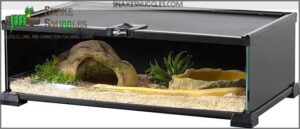
Looking for a cozy home for your snake? The REPTIZOO Small Reptile Tank Terrarium Habitat might be the perfect fit.
It’s built with sturdy float glass, so it’s tougher than your average tank.
Here’s what you can expect:
- Good ventilation
- A sliding door
- A safety buckle to keep your snake secure
It’s super easy to assemble—you can have it set up in just five minutes.
The blacked-out sides are great for reptiles that like their privacy, and the raised bottom frame keeps your snake comfy with a substrate heater.
Just remember, it’s not watertight, so no swimming adventures for your pet.
Best For: The REPTIZOO Small Reptile Tank Terrarium Habitat is best for small snakes, bearded dragons, spiders, leopard geckos, and other reptiles and amphibians that prefer darkness.
- Sturdy construction with float glass
- Easy assembly in just five minutes
- Blacked-out sides for privacy and a comfortable environment
- Not watertight
- Limited ceiling clearance for climbing
- Some reports of faulty latches or shattered tanks
2. Zilla QuickBuild Glass Terrarium
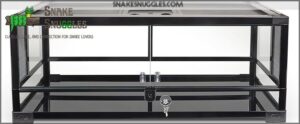
You’ll love the Zilla QuickBuild Glass Terrarium for your slithery friend. It’s a snap to set up – just 10 minutes and you’re done!
The tempered glass gives you a crystal-clear view of your snake’s antics.
Choose between a solid base for water lovers or a removable tray for easy cleaning.
Don’t worry about escapes; the locking system‘s got you covered.
Want to expand? These terrariums stack like building blocks. Just keep an eye on those tiny gaps at the top if you’ve got a Houdini on your hands!
Best For: The Zilla QuickBuild Glass Terrarium is best for reptile keepers who want a spacious, sturdy terrarium that’s easy to assemble and clean.
- Quick and easy assembly: Set up in just 10 minutes.
- Durable tempered glass: Provides a clear view of your pet’s habitat.
- Versatile design: Choose from a solid water-holding base or a removable bedding tray.
- Heavy: The terrarium is quite heavy due to the glass construction.
- Potential for escapes: Small gaps at the top might allow for small snakes to escape.
- Expensive: The terrarium can be pricey, around $400 CAD with taxes.
3. ECOFLEX Reptile Habitat Enclosure
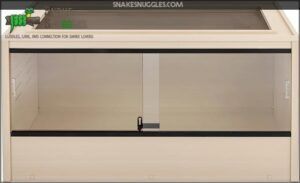
Looking for a sturdy, eco-friendly home for your slithery friend? The ECOFLEX Reptile Habitat Enclosure might be your perfect match. It’s like a green hotel for snakes!
Made from recycled materials, this enclosure is tough as nails with a 10-year warranty.
You’ll love how easy it’s to clean – no more wrestling with stubborn snake messes.
The vented sides and mesh top keep air flowing, while the lockable doors keep your escape artist secure.
Just remember, it’s not watertight out of the box, so you might need to break out the silicone sealant.
Best For: The ECOFLEX Reptile Habitat Enclosure is best for reptile owners who prioritize eco-friendly materials, easy cleaning, and secure enclosures.
- Made from recycled materials, promoting sustainability.
- Easy cleaning and odor control, making maintenance a breeze.
- Secure with lockable doors, keeping your reptile safe from escapes.
- Not watertight out of the box, requiring additional silicone sealant.
- Screen top may bow under heavy weight, potentially impacting ventilation.
- Humidity management might be challenging with the open screen top.
4. 120 Gallon Reptile Enclosure
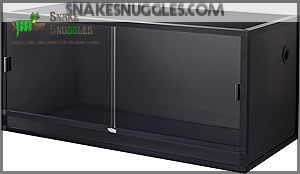
Looking for a spacious home for your snake? The 120 Gallon Reptile Enclosure might be your ticket to reptile paradise. It’s a breeze to set up—you’ll be done in less than 30 minutes! Made of durable acrylic, it’s like a five-star hotel for your scaly friend. The removable glass makes cleaning a snap, and its lightweight design means you can rearrange your snake’s digs without breaking a sweat. Just keep an eye out for any assembly hiccups, and you’ll have a roomy, affordable palace fit for reptile royalty.
Best For: Reptile owners looking for a spacious, affordable, and easy-to-assemble enclosure.
- Easy to assemble and clean.
- Durable acrylic construction.
- Lightweight and easy to move.
- Some reviewers reported assembly issues and damage.
- Customer service response time was slow for replacement parts.
- Instructions are online but not included in the box.
5. Reptile Branch Decor for Terrariums
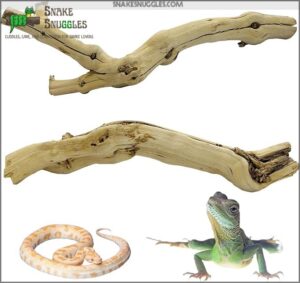
These natural wooden branches are perfect for creating a mini jungle gym in your snake’s vivarium.
They’re about 12 inches long, giving your scaly friend plenty of space to climb, rest, and even sharpen their claws.
Plus, they’re a breeze to clean – just give them a quick sun-dry before use.
These branches aren’t just functional; they’re like little works of art for your terrarium.
Whether you’ve got a corn snake or a chameleon, these branches will make them feel right at home.
Just remember, humidity and wood don’t mix well!
Best For: Snakes, lizards, and other reptiles who love to climb and explore.
- Provides a natural climbing surface for reptiles.
- Helps reptiles sharpen their claws and teeth.
- Adds a decorative touch to any terrarium.
- Can be difficult to clean in humid environments.
- May need to be replaced over time due to wear and tear.
- Not suitable for all reptiles, such as those who prefer to burrow.
6. 34 Gallon Reptile Terrarium Tank
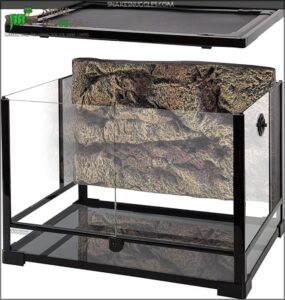
Ready to give your slithery friend a spacious new home? The 34-gallon reptile terrarium tank might be just the ticket. With its front-opening doors, you’ll have easy access for feeding time without any Houdini-like escape attempts. The raised bottom’s perfect for sneaking in an under-tank heater, keeping your snake cozy. Plus, that foam background’s a great canvas for your inner terrarium artist – stick on some fake plants and watch your snake’s habitat come to life. Just remember, this tank’s ideal for corn snakes under 3 feet, so plan accordingly!
Best For: The 34-gallon reptile terrarium tank is best for corn snakes under 3 feet.
- Easy access for feeding and cleaning.
- Raised bottom allows for under-tank heater use.
- Foam background provides a creative canvas for terrarium decor.
- May require additional modifications for specific needs.
- Could be fragile and require careful handling.
- May need extra assistance during assembly.
7. Reptile Terrarium Amphibian Tank
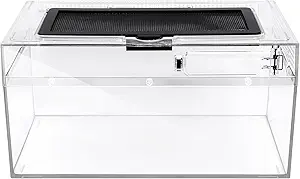
This Clioran terrarium is a great choice for your small snake!
It’s like a cozy condo for your slithery friend.
The one-piece design makes cleaning a breeze.
The clear polycarbonate gives you a 360° view of your pet’s antics.
You don’t have to worry about escapes – the screened lid has a handy feeding port.
While it’s not huge at 11.8" x 7" x 5.9", it’s perfect for pint-sized pythons or curious corn snakes.
Just remember, you might need to jazz it up with some decor to make it feel like home sweet home.
Best For: This Clioran terrarium is best for small snakes, like corn snakes or small pythons.
- The one-piece design makes it easy to clean.
- The clear polycarbonate provides a 360° view of your pet.
- The screened lid with feeding port prevents escapes.
- The small size may not be suitable for all reptiles.
- You may need to add decorations to make it feel more like home.
- The plastic screws can break.
8. Mossy Caves Reptile Hide
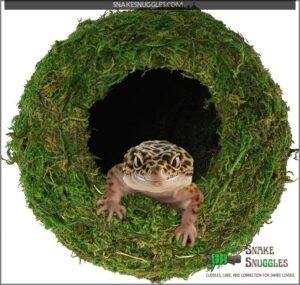
Looking to give your scaly friend a cozy hideaway? The USMOLA Mossy Cave might be just the ticket. This 4x4x4-inch hide, crafted from natural moss, offers a woodland retreat that’ll make your snake feel right at home.
It’s tough enough to handle humid conditions and UV light, perfect for enhancing your terrarium’s natural vibe.
But heads up – some users have reported mold issues when it’s wet, and there’s a chance you might find a sharp edge.
While it’s great for many reptiles, it mightn’t suit high-humidity lovers.
Best For: The USMOLA Mossy Cave is best for reptiles that enjoy a cool, dry hideaway.
- Made from natural moss for a natural feel.
- Durable and can withstand humidity and UV light.
- Provides a hiding spot for reptiles.
- Some users have reported mold issues when wet.
- There’s a chance of finding sharp edges.
- May not be suitable for reptiles that require high humidity.
9. 35 Gallon Glass Reptile Tank Terrarium
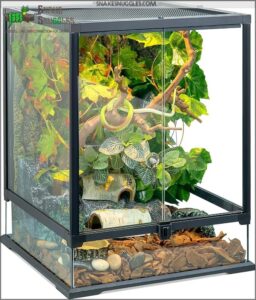
You’ll love BINANO’s 35-gallon glass terrarium for your slithery friend. It’s a window to your snake’s world, with unobstructed views from every angle. The watertight base is perfect for both land-loving and water-loving reptiles. No more escape artist antics, thanks to the front door’s anti-escape latch. Need to adjust the heat lamp? No sweat! The ventilated metal mesh top swings open easily. Plus, those pre-drilled cable holes are a real lifesaver for setting up your snake’s climate control. Just watch out for tiny bugs sneaking through the door gap!
Best For: The BINANO 35-gallon glass terrarium is perfect for owners of both terrestrial and aquatic reptiles who value clear viewing and a secure enclosure.
- Unobstructed views for observing your reptile.
- Watertight base suitable for both land and water-dwelling reptiles.
- Secure front door with anti-escape latch and convenient ventilation.
- Small gap between front doors may allow small bugs to escape.
- Raised bottom may require additional setup for heating pads.
- Made in China.
10. Exo Terra Forest Plume Moss 2 Pack
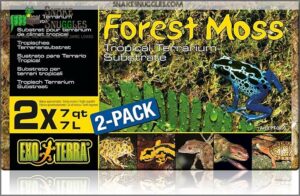
You’ll love the Exo Terra Forest Plume Moss 2 Pack for your snake’s vivarium. It’s like a humidity sponge, soaking up moisture and releasing it slowly. Perfect for creating that tropical vibe your slithery friend craves! This real, compressed moss from Asia expands impressively when wet, giving you plenty of coverage. It’s safe for all sorts of critters, from frogs to burrowing snakes. Pop it in shelters or use it as an egg-laying medium. Just be aware, some users found it a bit soggy, but hey, that’s what you want for humidity, right?
Best For: Reptiles and amphibians who need high humidity levels in their enclosures.
- Soaks up moisture and releases it slowly, creating a humid environment.
- Safe for a variety of animals, including frogs, salamanders, and snakes.
- Expands significantly when wet, providing ample coverage.
- Some users received only one brick instead of two, as advertised.
- Some users found the moss to be more "soggy" and "dirty" than other brands.
- It is very absorbent and can become quite heavy when wet.
Frequently Asked Questions (FAQs)
Can you keep snakes in a vivarium?
You’d think snakes prefer cozy cardboard boxes, but surprise! Vivariums are actually perfect for your slithery friend. They’ll provide the right temperature, humidity, and space for your snake to thrive. Just make sure it’s properly set up and maintained.
What is the difference between a vivarium and a terrarium?
You’ll find vivariums are designed for living creatures, with features like ventilation and heating. Terrariums, on the other hand, are primarily for plants. While both can house reptiles, vivariums are better suited for their specific needs.
Why is it called a vivarium?
Where there’s life, there’s a vivarium!" You’ll find this name stems from Latin roots: "vivere" (to live) and "-arium" (a place for). It’s called a vivarium because it’s a living environment for animals or plants.
What is a vivarium tank?
You’ve probably seen a vivarium tank before – it’s a glass or acrylic enclosure designed to house small animals. It’s like a mini-ecosystem where you can recreate your pet’s natural habitat, complete with plants and special lighting.
How often should I replace the substrate?
You’ll want to replace your substrate every 2-3 months, or sooner if it’s visibly soiled. Keep an eye on it and trust your nose – if it starts to smell funky, it’s time for a change!
Can multiple snakes share the same vivarium?
Ever wondered if snakes enjoy roommates? You shouldn’t house multiple snakes together. They’re solitary creatures and may fight, stress each other out, or even become prey. It’s best to give each snake its own space.
Are there snake-safe plants for bioactive setups?
Yes, there are plenty of snake-safe plants for bioactive setups! You’ll want to choose hardy, low-maintenance options like pothos, snake plants, or spider plants. They’ll thrive in your snake’s habitat while adding natural beauty and helping maintain humidity.
Whats the best way to clean vivarium decorations?
Like Hercules cleaning the Augean stables, you’ll want to tackle vivarium decorations regularly. Soak items in warm, soapy water, scrub gently with a soft brush, rinse thoroughly, and let them dry completely before returning to the enclosure.
How do I soundproof a snake vivarium?
You can soundproof your vivarium by adding foam panels to the walls and base. Use weatherstripping around doors and vents, and place the enclosure on a rubber mat. Don’t forget to maintain proper ventilation for your scaly friend!
Conclusion
Just like a master chef crafts the perfect dish, you’ve now got the recipe for creating an ideal snake vivarium.
By following these steps, you’ll transform a simple enclosure into a thriving, natural habitat.
Your snake will slither with joy in its custom-tailored environment.
So, get started and jump into the rewarding world of snake vivarium design.
Your scaly friend will thank you with years of healthy, happy companionship.

